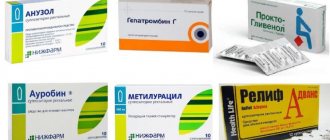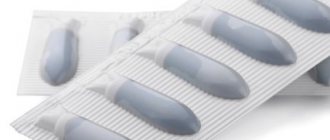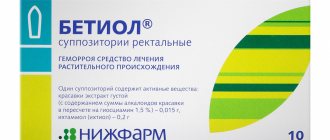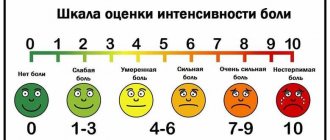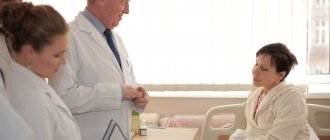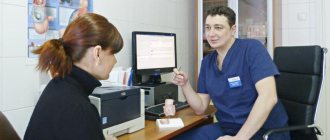All articles
Using suppositories for pain relief and treatment of hemorrhoids
26.09.2017
Suppositories for hemorrhoids are an effective treatment for the disease. The combination of various active ingredients allows you to eliminate the symptoms of the disease.
Today there are many effective ways to treat hemorrhoids. Symptoms can often be relieved with over-the-counter medications and lifestyle changes. One of the most popular remedies are suppositories, or rectal suppositories “for hemorrhoids”. Such candles have different effects and are used for specific purposes. Doctors do not recommend using several remedies to treat hemorrhoids at the same time. Also, you should not use medications containing glucocorticosteroids uncontrollably for longer than 5–7 days. Be sure to tell your doctor if your symptoms worsen while using them, such as increased itching.
Advantages and disadvantages of candles
Rectal suppositories are intended for insertion into the rectum. They contain an active substance and various auxiliary components. The candles soften and melt at the temperature of the human body, ensuring the supply of the active substance, and at room temperature they retain their shape.
Maintaining candles does not require outside help or special medical education, is a non-invasive treatment method, does not cause nausea and vomiting, and in most cases does not cause discomfort. Thanks to these advantages, rectal suppositories have gained popularity and are considered an effective remedy for hemorrhoids.
Like any other dosage form, suppositories also have disadvantages. Firstly, they require storage at low temperatures, often in a refrigerator. Secondly, using candles is not always convenient. Thirdly, some components of suppositories cannot be stored for a long time, so it is not recommended to buy suppositories for hemorrhoids for future use. Remember, candles cannot be used if they are cracked or damaged, or if their color or smell has changed.
Prevention
Simple rules can prevent pain from hemorrhoids:
- Regulates bowel regularity, preventing constipation;
- A balanced diet, following a special diet that does not irritate the intestines;
- Proper intimate hygiene;
- sensible exercises to prevent constipation in the anus;
- Annual medical examinations.
Pain relief is only a temporary solution; Expert advice is needed to accurately diagnose and treat the underlying cause.
The video about shading an aloe leaf has received more than half a million views.
Effects of rectal suppositories
Anesthesia
Reduce pain due to analgesic components (novocaine, lidocaine, etc.). Anesthetic suppositories for hemorrhoids are prescribed for acute pain.
Reduce blood clot formation
Achieved through anticoagulants, which block blood clotting mechanisms. After taking such suppositories, blood stops clotting normally, so patients with a tendency to bleed are advised to first consult a doctor.
Anti-inflammatory effect
You can relieve inflammation with the help of non-steroidal anti-inflammatory drugs (aspirin, diclofenac), as well as hormonal drugs (drugs containing glucocorticosteroids). Natural substances (sea buckthorn oil, propolis) are also widely used.
Stop bleeding
In this case, drugs that are opposite in action to anticoagulants are used. That is, they activate the blood clotting process, stop bleeding, but can lead to the formation of blood clots if used uncontrolled.
Strengthening veins
Achieved by increasing their tone, strengthening the wall, and increasing elasticity.
In order to increase the effectiveness of suppositories for hemorrhoids and ensure ease of use, they sometimes include several active ingredients.
For example, suppositories with analgesic, anti-inflammatory and hemostatic effects are popular.
Acute hemorrhoids - symptoms and treatment
Currently, there is no uniform treatment strategy for exacerbation of hemorrhoids. Some doctors almost immediately resort to surgical interventions, others only to conservative therapy, and consider surgery appropriate only after the acute process has subsided.
The optimal treatment for acute thrombosis of external hemorrhoids consists of both dynamic observation with complex conservative therapy and surgical correction. Surgical treatment is necessary if acute thrombosis of the hemorrhoid appeared 48-72 hours ago. During the operation, thrombotic masses are either removed from the hemorrhoidal node, or the thrombosed hemorrhoidal node itself is excised. Performing any of these methods within 48 to 72 hours of the onset of acute hemorrhoids will reduce recovery time. If the disease lasts more than 72 hours, then it is necessary to use conservative therapy to relieve pain and inflammation, followed by planned surgical treatment.[1][2][5]
Diet
If you have hemorrhoids, you should eat smaller meals and consume more foods rich in fiber: vegetables, fruits and bran. It is worth refraining from fatty, fried, canned, spicy foods, and also reduce the amount and strength of coffee and tea. It is important to drink enough liquid. This prevents the stool from hardening and promotes the free movement of feces through the intestines.
Drug treatment
Pain is usually relieved with the help of systemic analgesics (analgin, baralgin, ketonal) and local painkillers in various forms (suppositories, creams: anestezol, emla, relief-advance, relief-PRO).
For thrombosis of hemorrhoids, local anticoagulants are used, such as heparin ointment, hepatrombin-g. The use of phlebotonics that help restore the tone of the venous wall (detralex, phlebodia) is also justified. For thrombosis accompanied by inflammation, combination drugs containing an anesthetic and anti-inflammatory components (aurobine, proctoglivenol, drugs from the “relief” line) are indicated.
For bleeding, as a rule, local hemostatic drugs are used in the form of suppositories or ointments (for example, relief, natalsid), it is possible to use hemostatic drugs (tachocomb, hemostatic sponge). In some cases, they resort to prescribing systemic hemostatic agents (dicinone, sodium etamsylate, aminocaproic acid).
Operative therapy
If conservative therapy is ineffective or symptoms progress, traditional surgical treatment is resorted to. The use of minimally invasive techniques for acute hemorrhoids is very controversial, but most experts prefer traditional surgical methods.
The effectiveness of surgical treatment of hemorrhoids
All types of hemorrhoidectomy are the most effective methods of treating OH. The most commonly used are open and closed hemorrhoidectomy, which are performed using a surgical scalpel, diathermocoagulation, laser or ultrasonic scissors.
Closed hemorrhoidectomy (with restoration of the mucous membrane of the anal canal)
This technique is used if there are no clear boundaries between the external and internal hemorrhoids. A clamp is applied to the base of the internal hemorrhoid (above the dentate line). After that, the node is cut off to the vascular pedicle, which is then sutured and bandaged. When suturing the wound, the edges and bottom are captured with an absorbable thread. The external hemorrhoidal node can be excised either together with the internal node or separately.
Complications of this surgical intervention include bleeding in the postoperative period, anal incontinence (incontinence), stricture (narrowing) of the anal canal and constipation.[1][2][7][8]
Open hemorrhoidectomy
This method should be used when OH is combined with an anal fissure or rectal fistula. Excision of the internal hemorrhoid occurs in the same way as with closed hemorrhoidectomy. Thorough hemostasis (stopping bleeding) is achieved. It differs from the closed type of operation in the way the intervention is completed: the wound is not sutured.
The most common complications of this operation are anal incontinence, acute urinary retention and bleeding in the early postoperative period.[3][5][7][9][10]
Submucosal hemorrhoidectomy
The main advantage of this method is the complete restoration of the mucous membrane of the anal canal and rectum with a submucosal location of the stump of the node without deformation or tension. Before the operation, 2-3 ml of a 0.25% novocaine solution is injected into the submucosal layer near the internal node to create a hydraulic cushion. Then the mucous membrane above the node is dissected with two arcuate incisions - this helps to isolate this node from the surrounding tissues down to the vascular pedicle. After which the leg is stitched and the knot is cut off. The mucous membrane of the anal canal is sutured, while immersing the stump of the hemorrhoid into the submucosal layer.
Complications of the operation include reflex retention of urination and bleeding from wounds of the anal canal in the early postoperative period.[1][2][4][6]
Treatment during pregnancy and after childbirth
Hemorrhoids during pregnancy and during breastfeeding are treated with caution. Some drugs are contraindicated in certain trimesters and during lactation. The main method is local treatment - suppositories and ointments prescribed by a proctologist.
Folk remedies
Treatment of hemorrhoids with traditional methods does not have scientifically proven evidence. Without timely and adequate medical care, dangerous complications can develop, such as thrombosis, necrosis and gangrene. Therefore, if you experience pain, bleeding or prolapse of hemorrhoids, you should consult a proctologist.
First aid
When the first symptoms of acute hemorrhoids occur (in particular, pain), it is necessary, if possible, to immediately seek professional help, since there are no reliably effective methods of first aid that can relieve the acute period. In case of exacerbation, you should stop using toilet paper and avoid heavy physical activity. It is possible to use local anticoagulants (heparin ointment, hepatrombin-g), but they should be used with caution, since if the integrity of the node wall is damaged due to necrosis, intense bleeding may begin. The use of painkillers also has a number of certain difficulties: despite the elimination of pain, the progression of the disease will continue, and against the background of a subsided pain syndrome, the patient may postpone a visit to the doctor, thereby aggravating the course of hemorrhoids.
When the symptoms of OH subside, it is necessary to prevent the development of exacerbation in the future. For this purpose, it is necessary to treat chronic hemorrhoids. Today, there are many minimally invasive methods for treating this disease, which involve the use of modern laser, ultrasound, sclerosing techniques, as well as stapler and suture methods. The use of these treatment options makes it possible to minimize, and in some cases completely eliminate, pain and reduce the length of hospital stay to 1 day.
Features of application
When using suppositories, it is necessary to take into account their features and follow some rules:
- Carefully study the instructions for use and pay attention to storage conditions.
- Do not hold the candle in your hands for a long time, as it may begin to melt.
- If suppositories are used once a day, it is best to use them at night. If twice, then in the morning and in the evening.
- It is necessary to insert the suppository with clean hands while lying on your side, after bowel movements and performing hygiene procedures.
You can find out which suppositories for hemorrhoids are best for the patient, as well as how to take them correctly and for how long, after consultation with a specialist.
A comprehensive plan is drawn up individually for each patient, taking into account his age, gender, presence and absence of concomitant pathology and individual characteristics of the body.
Share:
How to relieve pain with folk remedies?
At home, the easiest way to get rid of hemorrhoids is with compresses, lotions or sitz baths.
Compresses
To relieve swelling, inflammation, and pain, use ice packs (ice packs on the painful area for 10 minutes every hour). Grate fresh aloe leaves, squeeze out the juice, moisten with a sterile cloth and apply to the inflamed nodes. Grate raw potatoes, wrap the pulp in gauze and place on the sore spot for 10 minutes.
Lotions
Lotions can relieve pain using herbal infusions: chamomile, calendula, nettle, plantain, brachypodium. The herbs reduce inflammation, improve blood circulation around the anus and relieve anal spasms. This helps improve the patient's condition.
Baths
For minor pain, cool sitz baths with the addition of herbal infusions: centanum leaves, aloe vera, nettle, oak bark, celery, algae, calendula.
